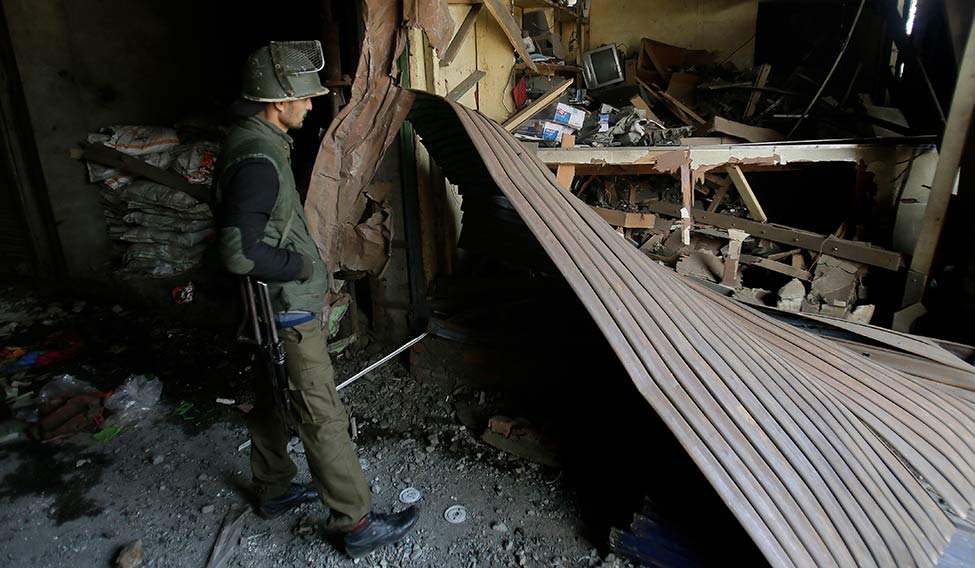His relatives and neighbours remember Fardeen Ahmad Khanday, 16, as a polite, helpful and studious boy. But, the class 10 student from Tral in south Kashmir had been gradually losing interest in studies. His father Ghulam Muhammad Khanday, a policeman, was not oblivious to the change. Intelligence sources said Ghulam Muhammad had shared his worries about Fardeen, who had allegedly got in touch with militants on social media, with his bosses.
Together, they attempted to deradicalise Fardeen. “Ghulam Muhammad tried every trick. From trying to persuade his son to move out and pursue higher education in another city, to an emotional appeal by his mother. Everything failed, and one day, Fardeen left home,” said a J&K police officer who requested anonymity. When Fardeen went missing, the police concluded that he had turned to militancy.
On December 31, 2017, they were proved right when Fardeen and two companions attacked the Central Reserve Police Force camp at Lethpora in Pulwama district. The Jaish-e-Mohammad claimed responsibility for the attack. “The fidayeen [who attacked the camp] were a mix of local and foreign terrorists,” said CRPF Director-General R.R. Bhatnagar. “This phenomenon has been observed over a period of time. We have come to know about Fardeen’s background and involvement only now. The J&K Police is looking into the matter.”
Counterterrorism experts said that sponsors of terror in Pakistan have once again found value in the JeM, which had lost its hold in the valley after Lashkar-e-Taiba became the first choice of the Inter-Services Intelligence. “Today, the JeM is on an upward surge, and Kashmiri youth, particularly in south Kashmir, are joining its fold,” said Arun Choudhary, former special director in the Intelligence Bureau. “[JeM chief Masood] Azhar had been keeping a low profile, unlike Lashkar patron Hafiz Saeed. But, over the last two decades Azhar has made several attempts to unite the jihadi outfits in the valley. Azhar’s ‘united jihad’ concept is now bearing fruit, and the biggest beneficiary of this is Pakistan’s terror machinery.”
Notably, the area in south Kashmir from where Fardeen hails has remnants of Harkat-ul-Ansar, the JeM’s parent organisation. It was after the Kandahar hijacking, orchestrated by Azhar in 1999, that Harkat-ul-Mujahideen and Harkat-ul-Ansar joined to form the JeM. Since then, it has carried out several strikes both in the valley and in other parts of India, the biggest being the attack on the Parliament in 2001.
“Masood Azhar is a potent force,” said Choudhary. “The fact that the JeM has claimed responsibility for the Pulwama attack shows that it wants to prove its capabilities. The JeM has always been most potent and violent in its activities. The resurgence of this group becomes evident from the fact that the number of recruits are on the rise. Clearly, it has the ISI’s support once again.”
Intelligence officers said they had precise information about the attack on the CRPF camp and inputs had been shared with the paramilitary force. The Research and Analysis Wing had also provided inputs. The CRPF campus is huge and some of the area is not fenced. The fidayeen used one of these unfenced areas to enter the campus—they used under-barrel grenade launchers to aid their progress.
“I would commend the CRPF personnel who effectively countered the attack,” said Bhatnagar. “One terrorist was intercepted at the outer cordon itself. But, the other two entered the buildings during the exchange of fire. The operation took some time, but all terrorists were killed. The casualties we suffered were during the retaliation.” He added that there has been effective coordination of the CRPF with the police and the Army in carrying out counterterrorism operations in the area.
Official data with THE WEEK shows that more than 100 militants were recruited in the valley in 2017, of which 60 per cent joined Hizbul Mujahideen, 30 per cent joined Lashkar and 10 per cent joined JeM. There are, at present, more than 230 active militants in the valley, of which 51 per cent are locals and 49 per cent are foreigners, intelligence sources said. The rise in local militancy is definitely making the security establishment sit up and take note.
Counterterrorist operations have been carried out by security agencies, including the J&K Police, paramilitary forces and the Army, to wipe out the menace. Last year, 217 terrorists were killed, of which about 40 per cent were locals.
But, the security top brass in the state as well as the Centre concede that counterterrorism operations are not enough. There is a need for sustained counter-radicalisation measures to save the youth, particularly teenagers, from the sustained indoctrination that is going on in J&K and other parts of the country.
No one could agree more than J&K Police chief S.P. Vaid. “We have launched concerted efforts to prevent the youth from joining militant outfits,” Vaid told THE WEEK. He said 75 indoctrinated youth were deradicalised in 2017. “Ten others, who had actually become militants, were also brought back,” he said. “Huge efforts were made by us with the help of their families, especially their mothers, to make them realise what they were doing was wrong and how much their families needed them.”
Union Home Minister Rajnath Singh, last week, exhorted the police chiefs of all states to focus on similar efforts. A special division has also been created in the ministry to coordinate such efforts by states.
The National Investigation Agency and the IB had recently infiltrated WhatsApp groups created by ISI-sponsored terror groups to recruit youth from J&K. Vaid said the society at large needs to come together to prevent gullible youth from new age methods of radicalisation and recruitment.







